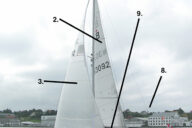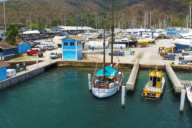Master this docking scenario with tips from our friend Capt. John of skippertips.com…
Imagine that you have a stiff 25-knot breeze blowing down the pier. The dockmaster has assigned you to a small space at the end. And you have no room for a long, slow approach from downwind. What sailing tips will you use to make this tough maneuver smooth, easy, and controlled?

Combine the power of your rudder, engine and forward bow spring line to dock in a narrow space. See more below.
I believe the #1 objective in boat control will be to face the dominant element for as long as practicable. Bow or stern. Keep this in mind in all maneuvers, whether docking or undocking alongside a pier or when you line up to enter a narrow boat slip. It’s too easy to get into a hurry and try to “bull the boat” through the elements (wind or current).
I’ve done this so many times and blown many maneuvers. Absolute basics seem to work best. Have a plan. But also have an exit plan in place in case the initial plan goes wrong. Break-away and try again.
Follow the steps below along with the illustrations. Practice in an open area on a quiet, crowd-less day. As in all docking or undocking maneuvers, learn the unique characteristics of your boat and modify these steps as necessary. Click here to download the all new, latest edition of the eBook Dock a Boat Like a Pro!.
1. Set Up for the Approach.
Rig the deck with a long spring line attached to a boat cleat on that side nearest the pier. Make up a roving fender to cushion the bow. If single-handed, rig a cluster of fenders (2 or more fenders bunched together) near the bow and along the side to provide protection.
Approach the dock upwind. Hold position with the bow into the wind about two to three boat-lengths off the pier (illustration 1). Pick an “aim point” to help you guide the boat into the pier. Note that we have chosen an aim point near a piling. We will use this piling for springing into the pier.
2. Maintain Aim-Point Control
Ease the bow to allow it to fall off the wind (illustration 2). Use rudder and engine to maintain this angle and to “sail” down your “aim point” approach line. Turn a wheel hard away from the pier; hold a tiller hard toward the pier. Use just enough engine throttle to hold this angle as you set down onto the pier.
3. Loop the After Bow Spring.
Form a loop from the cleated boat cleat around the piling and belay it (temporary) to the boat cleat (illustration 3).
4. Drift Aft Into the Docking Space.
Ease the forward bow spring line as you drift aft (illustration 4). Note in the illustration how the wind or current will work on the exposed side (in this case, the starboard side). Rudder position at this point will not be relevant. Wait until you are near your desired docking spot. Cleat off the forward bow springline. Go to the next step.
5. Belay and Dock Flush Alongside the Pier.
Place your engine throttle in astern propulsion at idle speed (or the slowest speed possible). Tension on the spring line will bring the boat flush alongside the pier. Once alongside, leave your engine in gear to maintain position (illustration 5).
As an alternate to the forward bow spring, put over a breast line (short, perpendicular line) near the beam. This line provides an ideal “first line over” for single-handers. Cleat off the breast line and it will hold you alongside nice and snug. Put over other docking lines as soon as you can. Remove the breast line if you intend to dock for any length of time. Otherwise the boat can “hang” on the breast line when the tide recedes.
~~~~~~~~~~~~~~~~~~~~
Practice this docking maneuver to master the secrets of control and line handling when short- or single handed. You will soon be “wowing” your friends with smooth, easy, and precise boat handling skills–wherever you sail or cruise!












